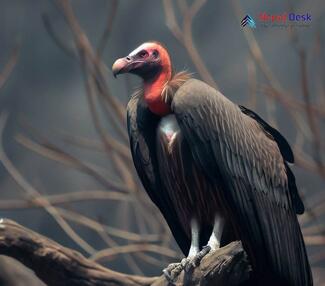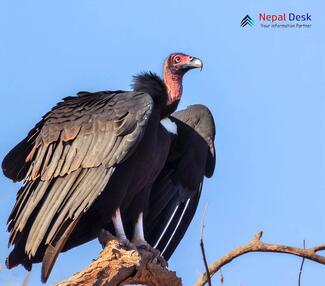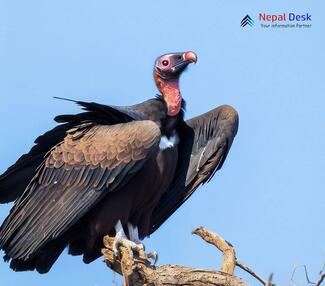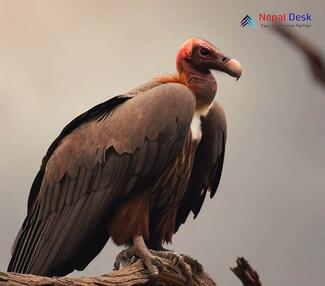The Red-headed Vulture (Sarcogyps calvus), often spelled as "Red Headed Vulture" is a striking and intriguing creature, that has captivated the attention of bird enthusiasts and conservationists alike. This fascinating bird has an array of distinctive characteristics that make it easily recognizable and uniquely adapted to its environment. Let us delve here into the taxonomy, physical features, habitat, diet, presence in Nepal, and some interesting facts about the Red Headed Vulture.
Taxonomy and Physical Features
Belonging to the family Accipitridae and genus Sarcogyps, the Red Headed Vulture is classified as Sarcogyps calvus. This species is part of a larger group comprising various eagles, kites, and other vultures.
This striking bird gets its name from its prominent red head that contrasts sharply with its black plumage covering the rest of its body. Adults have a deep red-to-orange face color that stands out against their predominantly dark feathers. They possess a robust build with a wingspan reaching up to 2.5 meters (8.2 feet) ensuring their agility in flight. The pale yellowish irises complete their unique appearance.
Habitat
The Red Headed Vulture inhabits various types of habitats such as grasslands, savannas, forests (both tropical and subtropical), or even cultivated areas. Their range spans from the Indian Subcontinent to Southeast Asia, with sightings occurring in parts of India, Nepal, Bangladesh, Bhutan, Myanmar (Burma), Cambodia, Laos, Thailand, and Vietnam.
Diet
As true opportunistic scavengers by nature, Red Headed Vultures consume carrion (dead animal carcasses) as their primary source of sustenance. Their excellent sense of sight allows them to scan vast landscapes in search of these carcasses with incredible precision. These vultures also perform the crucial ecological role of cleaning up the environment, thus preventing the spread of disease.
Presence in Nepal
In Nepal, the Red Headed Vulture has been designated as a critically endangered species by the IUCN Red List. The population has faced significant threats due to habitat loss, poisoning (from unintentional consumption of veterinary drugs in carrion), and the removal of large trees where they typically nest. Today, their presence in Nepal remains precarious, making conservation efforts critical for their survival.
The Red Headed Vulture is associated with the god Jupiter (known as Brihaspati). In ancient paintings, especially those depicting grand mythological scenes, these vultures are often depicted flying above drawn chariots as a symbol of wisdom and guidance.
The Red Headed Vulture is undoubtedly a remarkable bird with an array of fascinating characteristics. There is still much to learn about this enigmatic creature, which only adds to its allure in the eyes of nature enthusiasts and researchers. As we understand and appreciate its value within ecosystems, it becomes increasingly important to protect and preserve this extraordinary species for future generations to witness and admire.
Some facts about the Red Headed Vulture
Facing Extinction
Regrettably, the Red Headed Vulture is critically endangered, as their populations have seen dramatic declines lately due to various threats like diclofenac, a veterinary drug toxic to vultures.
Nest Builders
These vultures construct their nests high up in trees, often near human settlements. Their nesting areas are usually solitary, with vulture pairs occupying one tree.
Lifelong Residents
In the wild, Red Headed Vulture can survive for several decades, with some individuals living to be 40 years or older.
Sacred Birds
In some regions of South Asia, vultures such as the Red Headed Vulture are deemed sacred and connected to Hindu deities, holding cultural and religious importance.
Temperature Control
Vultures have unique adaptations for thermoregulation. They can defecate on their legs; as the moisture evaporates, it assists in cooling them down in hot environments.
Protective Measures
Numerous conservation organizations and government bodies of Nepal actively engaged in efforts to safeguard and preserve Red Headed Vultures and their habitats. Initiatives involve establishing vulture-safe zones and advocating for secure livestock management practices to prevent vultures' exposure to harmful veterinary drugs.
Sociable Birds
Red Headed Vultures enjoy the company of their kind and frequently scavenge together. Their presence at a carcass often invites other vultures, resulting in a shared feast.
Quiet Aviators
Unlike many raptors, these vultures don't make much noise while flying. They lack the typical loud calls or screeches of other birds of prey.
Lifetime Partners
Red Headed Vultures are monogamous and establish enduring pair bonds. Couples often team up when constructing and preserving their nests.
Broad Distribution
These vultures inhabit a widespread area, spanning South Asia, Southeast Asia, southern China, and the Indonesian archipelago.
Slow Breeders
With a low reproductive rate, Red Headed Vultures lay merely one egg each nesting season. The chick demands ongoing care before becoming independent.
Wing Communication
During courtship and territorial displays, these vultures signal with their wings. This behavior entails an array of rhythmic wing beats.
High-altitude Gliders
Renowned for soaring to great heights, Red-headed Vultures exploit thermal updrafts to ascend effortlessly.
Unusual Flight Style
They exhibit a distinctive flight pattern composed of short glides punctuated by brief wing flaps.
Seasonal Travelers
Some Red Headed Vultures display migratory tendencies, relocating in search of food throughout various seasons and covering significant distances.
Feasting Etiquette
At a carcass, vultures adhere to an eating hierarchy. Larger, dominant vultures dine first while smaller or lower-ranking individuals patiently await their turn.
United in Preservation
International conservation groups and governments join forces on vulture conservation endeavors. Initiatives include captive breeding programs designed to reintroduce these birds into the wild while closely monitoring their numbers.
Despite facing numerous obstacles, the Red Headed Vulture's fascinating traits render it a captivating species. Ongoing conservation efforts remain vital in preserving this critically endangered bird.




